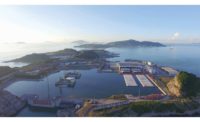Chinese contractors have hit the halfway mark of building an immersed-tube tunnel (ITT) between Hong Kong and Macao that, when opened in 2016, will be the world's longest, at 29.6 kilometers. But engineers in Denmark are in the final procurement phase for a project that will be three times longer: a Denmark-Germany ITT across the Fehmarnbelt waterway.
Final price bids for the 17.6-km-long Fehmarnbelt road-and-rail ITT are due this December, and work will start next summer, says Steen Lykke, technical director at Femern A/S, the government-owned Danish company in charge of the $7.6-billion crossing.
 |
| LYKKE |
The tunnel will link Denmark's Rødbyhavn and Puttgarden, which is located on the north side of the German island of Fehmarn. It will include 79 standard ITT elements, plus 10 deeper special units to house equipment at 1.8-km intervals. Weighing around 73,500 tonnes each, the 217-meter-long standard units will be about 42 m wide and 9 m tall.
The two biggest contracts will cover the northern and southern halves of the tunnel. Dredging work, including the 18-km-long, 80-m-wide and 10-m-deep trench, comprises another contract. The fourth contract covers portal structures and other land facilities on both coasts.
Firms from Belgium, Denmark, France, Germany, Italy, the Netherlands, South Korea and Spain formed nine consortiums that submitted 17 technical bids for the four contracts.
Among non-Scandinavian main contractors are Germany’s Hochtief Solutions A.G., Ed Züblin A.G., Wayss & Freytag Ingenieurbau A.G. and Max Bögl Bauunternehmung.
The Netherlands is represented by Boskalis International B.V., Van Oord Dredging and Marine Contractors B.V., and units of Royal Bam Group.
From the U.S., Great Lakes Dredge & Dock Co., Oak Brook, Ill., is a subcontractor for one team. The U.K. is represented by London-based design firms Capita Symonds PLC and Mott MacDonald Group, each advising different bidders.
Femern A/S and the contractors are now beginning "competitive dialogue," which is a European Union negotiations procedure designed for projects that are complicated or require innovation.
The process aims “to make sure [the contractors] have understood our requirements and that we have understood their proposals,” says Lykke. Bids are based on the owner’s illustrative designs, which allow for variations within constraints, Lykke adds.







Post a comment to this article
Report Abusive Comment